Our view at Stack - Shopify has just about everything you need if you're looking to sell online. It excels with unlimited products, user-friendly setup, and 24/7 support. It offers 6,000+ app integrations, abandoned cart recovery, and shipping discounts up to 88%. Plus, it allows selling both online and in-person, scaling as your business grows.
Let’s talk about product data, and more specifically, product taxonomy, a critical part of selling products online, but something you may not have thought much about before.
Product data takes many forms, from the names, descriptions, and images of your items, to classification data like the product’s category, options like size or color, and all the different variations your products may come in. A product taxonomy is the underlying model that ties a lot of this data together.
Product data is an integral part of your Shopify store, woven throughout every aspect of your shop, and has a big impact on buyer conversion, playing a major role in how customers find and interact with your products. It powers everything from on-site search and filters to how items are displayed on platforms like Google or our Shop app. It’s why getting it right can really make a difference.
If you’ve been managing product creation in Shopify, you’ve likely noticed that it involves some manual input, such as entering size options like “small” or “large” and color values like “red” or “blue.” While this process has been somewhat time-consuming and prone to human error, it has also been an essential part of the setup. Additionally, Shopify has historically provided default options like size and color for all products. However, we recognize the challenge in capturing the diverse and unique attributes of the millions of products sold online, which previously required manual effort to set up.
At Shopify, we know how important it is to have accurate and comprehensive data associated with each of your products, so over the last few years we’ve been investing heavily in some major updates of our product model. With that in mind, we’re thrilled to introduce Shopify’s Standard Product Taxonomy and the associated concept of product attributes, available now by default on all Shopify stores. Our standard product taxonomy improves and speeds up the way you create and classify products, makes it easier to sell cross-channel, and most importantly, drives more discoverability of your products.
What is Shopify’s Standard Product Taxonomy?
Shopify’s Standard Product Taxonomy is a giant library of product data across more than 26 business verticals that maps over 10K product categories with over 1K associated product attributes. Here’s a look at the full and expanded taxonomy.
In a nutshell, every product maps to a specific product category in the taxonomy. For example, let’s say you’re selling a chair, which under the taxonomy is classified in the specific hierarchy you can see below (Furniture -> Chairs -> Kitchen & Dining Room Chairs).

Shopify’s Standard Product Taxonomy is a public repository, allowing us to collect critical input from our merchant and partner community to continually refine our standard product categories and associated attributes. We’ll also continue to monitor how our merchants are using and customizing attributes in their stores, layering in some of these important trends and changes back into our taxonomy.
These refinements are always backwards compatible, ensuring that any updates to the taxonomy model will not interrupt the merchant experience, and merchants will be able to benefit from any new product attributes as soon as they are added.
Creating products using Shopify’s Standard Product Taxonomy
When you create a new product in Shopify, by default, it automatically leverages our new taxonomy. Let’s walk through an example to see how this works.
After clicking “Add product” on the Products page in Shopify admin, you’ll enter a name, description, and add the images that you’d like to highlight on your product details page. And this is where AI works hand-in-hand with our taxonomy to help you classify and store the most important, relevant data on your product.
With the help of Shopify Magic, our algorithms can now use your product name, description and images to suggest your product category, which you can see in the Category card directly below your product images.
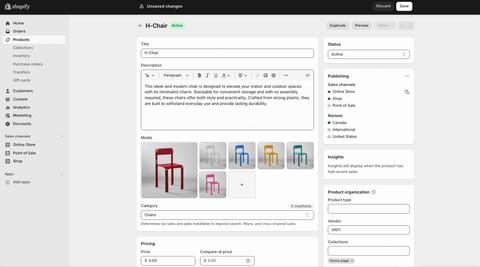
You can automatically use the magic-selected category, or you can refine the category (and remember, you want it to be as specific as possible to ensure you have the most accurate associated product attributes), Shopify’s Standard Product Taxonomy surfaces your list of default associated product attributes that come with your product category. You can see them listed in the Category metafields card (Category metafields is how we refer to product attributes in Shopify admin).
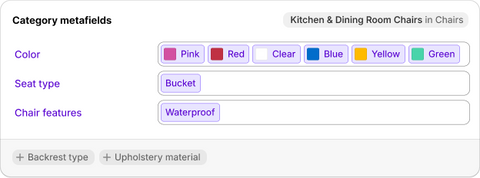
Product attributes are a brand new concept that are launching for the first time along with Shopify’s Standard Product Taxonomy. Product attributes are implemented as category-specific product metafields in Shopify, and are accessible in the same surfaces as all other product metafields.
While the concept of the product category existed before we launched our new taxonomy, a pivotal upgrade in our model is the introduction of these category-specific product attributes and predefined values. Each category triggers a relevant set of attributes, tailored specifically for that category. Now, each product isn’t just categorized—it’s richly detailed and perfectly aligned with what your customers seek.
In our example above, Shopify Magic detected some predefined attribute values: color, seat type, and chair features based on product description and uploaded images.
You can even create your own custom color names, depending on your preferences. All of these attribute values are saved for you, so you can re-use them when creating or updating other products, and even edit them in one central place, saving time and minimizing any manual data entry.
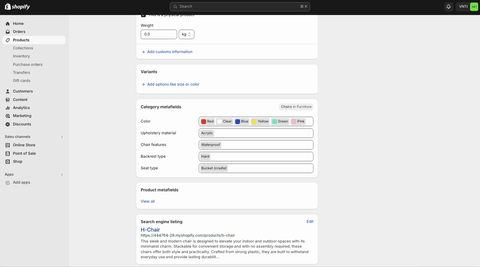
Product attributes and attribute values can also be used to power your product options – standardizing how variants are managed across all your products. This not only creates consistency across your product storefront experience, but also provides the flexibility to choose, on a per product basis, which attributes differ by variant, and which stay consistent. Let’s take an example.
A bar stool may sell in a single white finish, but multiple height sizes, while a chair in your store may sell in varying colors, but a single size and material composition. With product attributes, you can, on a per product level, decide where this information is most relevant.
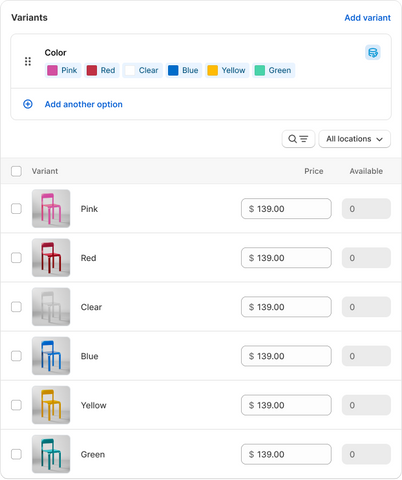

New: Native support for swatches
Now that you’ve set up your products using Shopify’s Standard Product Taxonomy, let’s take a look at your buyer-facing product details page. One of the exciting updates shipping along with our taxonomy is Shopify’s native support for swatches. Once you’ve set up your color attributes in Shopify, if you’re on version 14 or above of a first-party Shopify theme (such as Dawn), you’ll see that swatches will automatically render for you on your storefront, without any additional effort involved.
You’re also able to leverage Shopify’s native support for swatches even if you’re on a custom theme. Learn more about this here.
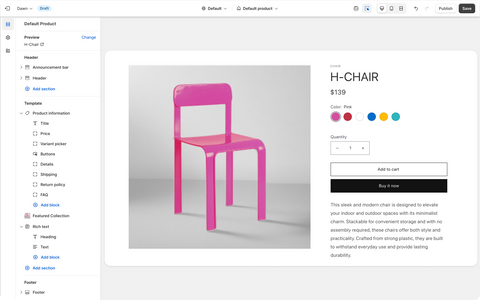
The benefits of Shopify’s Standard Product Taxonomy
Streamlined product creation and classification
With Shopify’s Standard Product Taxonomy now equipped with AI-enabled recommendations, creating and managing your products becomes faster, more efficient and less error-prone.
At each step of your product creation process, Shopify will surface product data suggestions that stem from both our taxonomy and Shopify Magic – whether it’s your product category, the category-specific product attributes, or the associated attribute values. This dramatically speeds up the process to create a product, eliminating the need for manual data entry, and ensuring the data you save is standardized across your entire product catalog. Creating product variants is now a breeze too, with the ability to quickly create your options and variants directly from your product attributes.
You can also rest assured that your products are being classified according to a world-class taxonomy model that offers the most relevant attributes for all your products. What’s more, the model will continue to be updated as industries evolve, ensuring that your products will always be supported by the most up-to-date product information.
Better product discoverability
Shopify’s Standard Product Taxonomy, and especially product attributes, make a big impact in driving better visibility for your products.
Pre-packaged product attributes help you to immediately understand the type of information that buyers are looking for when searching for your products, leading to a more consistent shopping experience that increases buyer confidence over time.
Additionally, Shopify’s Standard Product Taxonomy will enable your buyers to experience more accurate and relevant in-store search results than ever before, powering the future of Shopify’s storefront search.
Coming soon, product categories and their attributes will work seamlessly with the Shopify Search & Discovery app, enabling merchants to create storefront filters for their buyers that leverage attributes like material or size and categories like televisions or candles.
Product categories and their attributes will also soon be able to facilitate the creation of automated collections, making it faster than ever to spin up collections of products based on attributes like color or age and categories like snowboards or tableware.
Easier cross-channel selling
Already selling or looking to sell your products on sales channels outside of Shopify? A big benefit of Shopify’s Standard Product Taxonomy is that it makes it easier to sell on additional channels.
Like Shopify, sites like Google and Instagram all have their own respective product taxonomies. With our new standardized taxonomy, marketplaces and search engines will more clearly understand and recognize product data coming from Shopify, streamlining the synchronization of this data and facilitating a smoother integration.
What’s more, this tighter alignment between our categorization data and other sites’ requirements means less data entry and reduced duplication of efforts when publishing cross-channel. As a result, your products will perform better on these channels due to more seamless data syncing.
We’re currently working with Google to improve the cross-channel selling experience with Shopify’s Standard Product Taxonomy, and we’re actively working to extend this seamless integration across other sales platforms such as Shop, Facebook, and Instagram. Keep an eye out for these improvements, which will further simplify managing your multi channel presence.
How to get started using Shopify’s Standard Product Taxonomy
Moving forward, all Shopify merchant stores were enabled with Shopify’s Standard Product Taxonomy, which means that any product you create is now powered by our taxonomy and uses product attributes.
For products that were already created on Shopify, you’ll need to set your category and attributes in order to receive all the benefits of Shopify’s Standard Product Taxonomy. Learn more about updating your existing products here.
If Shopify is of interest and you'd like more information, please do make contact or take a look in more detail here.
Credit: Original article published here.
